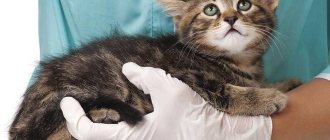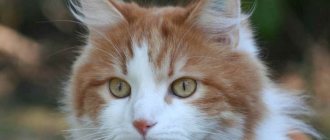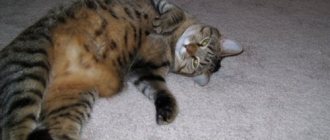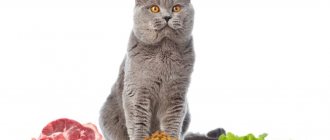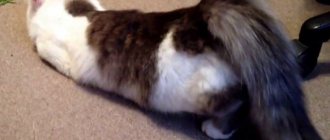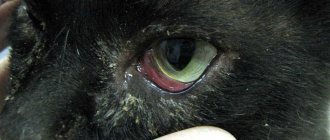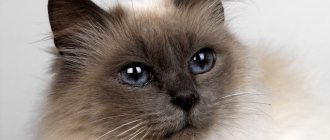Cat owners quite often note various oral problems in their pet. Some diseases can be treated at home, such as plaque on the enamel surface, bad breath, and inflammatory processes on the gums. But there are situations when a cat breaks a fang, in which case an independent solution to the problem is impossible. It is recommended to immediately contact a veterinarian for treatment, restoration or removal of the damaged element. The method of treatment is determined by the veterinarian, based on the collected medical history, examination results, and the degree of damage.
When do kittens lose their baby teeth?
Kittens are born toothless. At 7–14 days of age, their primary incisors appear. By 2 months, babies should normally have 26 teeth. As they grow older, they fall out and permanent units grow in their place. Hair loss begins at 3–4 months of age. The process of changing teeth takes approximately 3–4 months, being completely completed by 7–8 months.
The first to erupt are the permanent incisors - the anterior units responsible for biting food. Then fangs appear, which perform the function of holding and tearing food. The last to be cut are the molars and premolars. Chewing teeth have the thickest walls and the widest bases to serve their owner for at least the next 7–8 years.
Pathological causes
Owners should be alert to the loss of teeth at the age of an animal from 1 year, when permanent teeth fall out. It is important to understand that a cat’s teeth do not simply fall out, with the exception of milk teeth. Most likely, the pet has serious health problems, not only in the oral cavity, but also in the internal organs.
Signs of pathology are:
- hyperemia and swelling of the gums;
- bleeding lines near the gums;
- ulcers on the lips and gums;
- ulcers, pus in saliva;
- hypersalivation.
When observing a cat, you will notice that it is irritable, sometimes aggressive, and refuses food, even if it is hungry. When trying to eat, your pet does it very slowly and tries to chew only on one side. He also drinks reluctantly. You can tell that an animal has a problem by its strong smell - its breath stinks very strongly.
The causes of tooth loss include:
- Disturbance of the microflora of the oral cavity (dysbacteriosis).
- Injuries.
- Weakening of the immune system.
- Vitamin deficiency, which can be caused by a lack of B vitamins, iodine, fluorine and phosphorus in the feed used.
- Long-term treatment with hormones and antibacterial drugs.
- Tartar, which is a dark plaque on the enamel that must be removed.
- Diseases of the teeth and gums (periodontitis, gingivitis, stomatitis, caries, pulpitis).
- Infections, viruses.
- Malocclusion.
- Gastrointestinal diseases.
- Oncology.
In case of injury, as a rule, fangs and front incisors fall out; in case of internal diseases, absolutely any tooth can fall out. Molars and premolars fall out extremely rarely.
Causes
A tooth can break for many reasons. A small crack in the enamel leads to the destruction of dentin and exposure of the pulp, which can lead to tooth loss. The tooth root or crown may also be partially or completely damaged.
Typically, dental injuries in pets occur due to bad falls, car accidents, fighting with each other, or injuries to the jaw bones.
A pet’s teeth can break above, below or at the gum level, and the fracture itself can be either vertical or horizontal; subsequent treatment will depend on these indicators.
At what age do cats normally lose their molars and in what order?
In adulthood, these animals should not lose teeth. Normally, they fall out once during their life - when changing temporary units to permanent ones. Some people mistakenly think that tooth loss in older animals is normal. However, even in old age this should not be the case. In all cases, tooth loss in cats is a consequence of some internal or external problem.
Tartar removal
Tartar causes pain and tooth loss. Fangs are most often affected. Owners of four-legged pets should know what to do when a cat's fang falls out and how to prevent the loss of other teeth.
The stone is removed independently:
- Can be treated with hydrogen peroxide. Moisten the gauze and clean the problem area. Rinse your mouth with a decoction of herbs.
- They are given toothpick toys to chew on.
- Use a silicone brush - put it on your finger and clean the sore spot.
- Polish the stone with a cloth soaked in a special solution.
Note! When they can’t cope, they go to the vet. The doctor removes the stone manually or with ultrasound.
Oral hygiene - prevention of dental diseases
How to feed an animal whose teeth have fallen out or been removed (all or several)?
The diet of an animal that for some reason has lost one or all teeth should consist exclusively of soft food. It can be fed wet ready-made or pre-soaked dry food. Do not use broth or milk to soften the granules. It can only be soaked in water whose temperature does not exceed 30°C. Under the influence of hot liquid, the proteins contained in dry food are denatured, ascorbic and folic acid, thiamine, carotene and riboflavin are destroyed, and vitamins A, D and E are oxidized.
Cat food should be at room temperature. Too hot or cold food is contraindicated for animals with sensitive gums.
Ways to solve dental problems
How to brush a cat's teeth: options at home
Pets can have caries and gingivitis, as well as osteomyelitis and periodontitis. At first they all look like caries: the enamel is destroyed. Therefore, only a good veterinarian can accurately diagnose the problem.
Regular caries goes through several stages before a cat's gums become inflamed. Pain appears precisely from this, already in the later stages.
A sign of caries is a white spot on a canine or premolar. At this point, the owner can still help the cat. The stain is treated with hydrogen peroxide, and the mouth is washed with herbal infusions.
When they can’t help, they go to the vet. The dentist has special cauterizing agents in his arsenal. If they do not help, or the disease is advanced, the diseased element is removed. The operation is performed under full anesthesia, and the wound is sutured.
For several days after this, the animal is given painkillers.
Problems are solved using other, less drastic, methods:
- Organize proper nutrition. You need to feed your cat moderately soft food, but with layered solid inclusions. This provides the necessary load on the gums.
- They use drugs to strengthen teeth: antibiotics, antiseptics. When infections are eliminated, inflammation does not occur in the oral cavity, which leads to dental diseases.
- Strengthen the gums with ointments Metrogyl Denta, Dentavidin. The drug Zubastik helps a lot.
- They give vitamins and immune support products. Which ones are determined by the veterinarian after examining the animal. A weak immune system and lack of vitamins and minerals in the diet lead to weakened gums. They bleed and become breeding grounds for bacteria and germs.
- Strengthen teeth with nutrition: Denta-Kiss Gimpet (2-4 tablets daily), Beafar crispy pads (5-6 pieces per day), Happy cat cookies.
How are cats' teeth removed?
Artem: “How do cats remove teeth?”
Most often, the causes of dental problems are various diseases, which are also characteristic of both indoor and outdoor cats.
- Features of the structure of the jaws and teeth in cats with short muzzles and upturned noses. Typically, problems are more common in cats of breeds that have been more selective than others.
- Presence of plaque and tartar. Because of them, various inflammatory processes develop, which can lead to loosening and damage to the teeth.
- Injuries associated with damage to the bones of the skull and jaws.
In such situations, it is necessary to remove teeth from cats if they cannot be cured in any other way.
In order for the extraction of teeth in a cat under anesthesia to be successful, you should not feed the animal at least 7 hours before the operation. Otherwise, due to the anesthesia, she may begin to feel sick, and she risks choking on vomit or dying from shock.
When performing an operation, there is a risk that the animal will not wake up after anesthesia. Old and severely weakened cats, those with heart disease or lung problems are especially susceptible to this.
The anesthetic drug is administered intravenously, usually into the paw, after first clearing the area of skin from hair. During the operation, additional anesthesia in the form of a special gas may be given. Typically, a special cone-shaped mask is used for this.
If the type of intervention does not allow the use of a gas mask, intubation is performed.
After tooth extraction, the cat may feel unwell and may vomit. The animal suffers from weakness and lack of appetite, and in some cases, after the operation, the cat’s gums become very inflamed, so the doctor prescribes antibiotics, which will most likely have to be injected. This is necessary if the veterinarian said so, because inflammation can “spread” to neighboring, healthy tissues.
During the recovery period, your cat needs to be provided with high-quality soft food so that she can eat well even while her gums are still irritated.
In order not to have to resort to such a radical measure as tooth extraction, you need to constantly monitor their health, remove plaque and tartar in a timely manner, and also provide the animal with high-quality healthy food.
Useful materials:
- Cloudy eye in a cat Common causes of cloudy eyes in a cat The most common causes of cloudy eyes are glaucoma, cataracts or keratitis.…
- A cat’s liver How to determine that there is a malfunction in the liver All harmful substances that enter the cat’s body with ...
- Transporting a cat on an airplane Conditions for transporting a cat on an airplane There are generally accepted norms and rules for transporting pets in passenger…
- White feces in a cat What can the feces of a sick animal be like? In the tray of his pet, the owner may find feces that differ ...
Preventing tooth loss in cats
In order for your four-legged pet to retain all its teeth until the end of its life, the following rules must be followed:
- regularly remove plaque and tartar;
- feed your four-legged pet correctly;
- when feeding your pet natural food, periodically give it vitamin and mineral complexes, having previously agreed with your veterinarian;
- Conduct preventive veterinary examinations at least once a year;
- promptly treat diseases identified in the cat;
- When feeding an animal with ready-made food, agree on the chosen brand with your veterinarian;
- protect your four-legged pet from falling from a height, collision with vehicles, fights with relatives;
- Correct your cat's malocclusion in a timely manner.
Share with friends!
The procedure for removing teeth from a cat or how to pull a tooth out for a cat
Provide your pet with proper dental care: brush his teeth at least once a week, periodically remove tartar, give vitamins and periodically visit a veterinarian for an oral examination. Even if a cat’s tooth was pulled out and everything else is fine, this does not mean that further care is not needed.
Only a veterinarian can remove a tooth from a cat after first administering anesthesia. If a cat's teeth have been removed, it is necessary to first check the condition of the gums in this place so that inflammation does not appear.
Diagnosis and treatment
To prescribe adequate therapy, the doctor must conduct a diagnosis, which includes collecting information that will help him determine why the cat has bad breath and teeth falling out, a visual examination of the animal, and laboratory tests.
The main treatment measures include:
- Adjusting your diet.
- Elimination of the underlying disease.
- Removal of tartar (if any).
- Fortification, strengthening the immune system.
- Taking medications that strengthen teeth and reduce bleeding gums.
How can you tell if your teeth have changed?
The appearance of permanent teeth differs from temporary teeth. Milk ones, as a rule, are very sharp, akin to a well-sharpened dagger; the fangs have a curved shape and thinning in the gum area. While the permanent canines are straight and more rounded at the ends, and the neck is without thinning.
By the way, when changing teeth, you should not be afraid of the so-called polyteeth, when a kitten suddenly has 8 fangs instead of 4. The fact is that the molars are not formed in the same alveolus as the temporary ones, but nearby. So it turns out that one fang has not yet fallen out, but a new one has already grown.
In rare cases, a growing tooth pinches the root of the milk tooth, then the kitten begins to feel discomfort: it does not eat, periodically squeals pitifully and generally feels unwell. The problem is not global and is easily solved by removing the extra tooth.
You should not try to remove it yourself; it is better to take your baby to the veterinarian. It is possible that local or general anesthesia will be required. At the same time, the doctor will check for what reason the pathology occurred (perhaps the kitten has an incorrect bite or a developmental anomaly).
Symptoms
A broken tooth may not bother a cat and it will not show any external signs. In severe cases, the animal may experience pain not only in the tooth itself, but even in the entire jaw and head. Typically, a manifestation of dental problems will be a cat’s refusal to eat, and a constant desire to hide somewhere. The following symptoms indicate that a cat has broken a tooth :
- The tooth changes color and shape, its location shifts,
- Swelling appears on the animal's face,
- The cat refuses to eat
- The animal refuses to play and does not bite toys.
© shutterstock
If your animal develops similar symptoms, you should contact your veterinarian. A suspected broken tooth falls into the emergency category, and before starting therapy the animal must undergo the following tests :
- Pet examination,
- X-ray of the jaw,
- Examination of the tooth with a periodontal probe,
- Clinical and biochemical blood test.
Preventive measures
It is recommended to visit the veterinarian once every six months so that he can examine the animal’s oral cavity for the formation of tartar. If it is not possible to visit a veterinary clinic, you need to regularly examine your pet yourself.
Timely cleaning of teeth from plaque (about once every 5 days) can significantly reduce the risk of tartar formation. It is recommended to introduce the animal to this procedure from a very early age so that its indignation does not interfere with cleaning.
Regular dental examination and brushing are the most effective means of preventing dental plaque.
The food your cat eats should contain tough ingredients and grass. There are foods on sale that contain special granules that clean the surface of the teeth mechanically and contain polyphosphates; they settle on the teeth and prevent the formation of plaque. Taking multivitamins helps maintain dental health. And by allowing your cat to chew on cartilage, chicken necks, or letting you play with a toy, you will reduce the likelihood of plaque on your teeth to a minimum.
The influence of old age
In a healthy pet, age has no effect on the condition of the teeth. If your cat has lost a tooth, it is definitely not due to old age, but due to health problems, improper maintenance, feeding and care. Unless your cat is twenty years old or older. Cats very rarely live to this age and anything can happen to their body, because the very fact that a cat lived to be twenty years old is a miracle!
As they age, their teeth wear down. The lower incisors are the first to change shape, and then the surface of the back teeth is smoothed. The last to undergo changes are the fangs.
The cat broke a tooth: what to do?
If your cat has a broken tooth. First of all, check whether there is inflammation, what condition the other teeth are in, whether it hurts the cat to eat, whether there is discomfort when eating, and in general, pay attention to the behavior of the animal; perhaps the cat has a toothache.
If a cat has a broken tooth and it does not cause concern to the animal, there is no need to do anything; at home this is not as important as for wild cats for hunting. If there are still nuances, something is confusing, it’s better not to delay.
If your cat breaks a tooth or knocks it out at the root, you can get a crown. In some cases, it is necessary to remove a cat's tooth. The same thing is done if the cat knocks out a tooth.
What to ask from a doctor
For animals, as for people, going to the doctor is not the most pleasant event, and for some it is even stressful. If possible, such pets are left at home and a veterinarian is called to the house.
In your case, you will have to coax the cat a little and take him yourself, because he cannot collect all the tests the doctor needs at home.
Veterinarians generally love animals and want to help them, but not everyone loves their job. If you know your doctor well and have been taking your pet to him for many years, then you have nothing to worry about. If the doctor is new to you, make sure that he does everything necessary to make a correct diagnosis.
The veterinarian must:
- Ask in detail about your cat’s lifestyle, its diet and general condition.
- Carefully examine the oral cavity with special instruments.
- Take the necessary tests.
Precautions
From three to six months, the kitten should receive all the nutrients it needs. If the kitten eats the same thing as you, you need to give it additional vitamins and supplements.
It is better to choose professional dry food for kittens. The kitten must be able to chew something, otherwise he will begin to taste furniture and other things, and this is not good for either him or you.
Ko6e4ka.ru advises buying special chew treats and food with large granules.
During the period of teeth change, the kitten's immunity is very weak, so vaccines cannot be given. You should also avoid contact with other animals.
If the gums are severely inflamed and the molars begin to grow incorrectly, contact your veterinarian.
Cat's tooth is loose
If a cat's tooth is loose, there may be several reasons for this. An adult cat may have a loose tooth due to a lack of vitamins or poor nutrition. Also note that you should not give too much fish to your cat, as vitamin B is washed out of the animal’s body. If a kitten’s tooth is loose, it may be a baby tooth and will soon be replaced by a molar. In any case, if you are not sure about the correctness of the treatment or prevention you have chosen, contact your veterinarian, he will really help determine the causes of the disease, and not just see the consequences.
| In our cattery you can “buy a real British kitten.” We have many different colors, we will help you choose and answer all your questions! |
What treatment is prescribed?
If diagnostics show that the primary source of dental disorders is internal pathologies, then therapy aimed at eliminating them is first prescribed. If a kitten's fang falls out during a tooth change under one year old, no treatment is prescribed. During this period, it is important to monitor the condition of the oral cavity and feed the baby high-quality and balanced food.
If the symptom is associated with some external traumatic factors, then antibiotics may be included in the therapy.
When a cat's teeth are knocked out or mechanically damaged and sticking out, the doctor will remove the remains and prescribe a drug therapy regimen, including antibiotics and painkillers. If an elderly cat loses a long fang, this is also not considered a pathology. To maintain the body, the doctor will recommend taking courses of vitamins, as well as switching to soft and crushed foods.
Age-related changes in the dental system of cats
The age of cats can be easily determined by their teeth, or more precisely by the degree of their wear. The central and lateral incisors of the lower jaw are the first to wear off; with age, the surface of all incisors takes on a transverse oval shape. The more teeth a cat has, the older it is. The very last to be involved in the process of enamel abrasion are the fangs.
Senile tooth loss, especially the canines, is quite rare in cats and occurs mostly due to improper care. Although it is quite natural that if an animal reaches twenty years of age, it is unlikely that it will have the number of teeth given by nature in its mouth. Most likely, you will definitely miss a couple or three pieces.
KotoDigest Thank you for subscribing, check your inbox: you should receive an email asking you to confirm your subscription
Veterinary assistance
Treatment depends on the severity of the injury. So, if only the dentin is damaged, the veterinarian coats the tooth with fluoride or sealant; these substances minimize pain and prevent infection of the pulp. If the damage to the tooth is severe, the tooth must be removed.
If the damage was deep and affected the pulp, then the cat is recommended to fill the dental canal and install a dental crown.
If the breeder finds a small crack on a tooth, then special plates will be installed to prevent the pet from losing a tooth.
If the crack occurs due to injuries to the jaw, then the initial treatment will be the jaw bones themselves, and only after the jaw has been restored should the damaged tooth be treated. A case where a tooth moves out of its socket is also considered severe. If this occurs, the tooth should be immediately returned to its place, and subsequently the doctor will take measures to maintain the position of the tooth.
Some breeders think that if a cat has a broken fang, it will greatly affect the cat's quality of life, this is not true. Cats quickly adapt to this situation and the loss of an upper or lower canine does not affect the quality of chewing food.
Symptoms of tooth change
The owner can learn about the beginning of the process by the following signs:
- The animal has increased salivation.
- Upon visual examination, bleeding from the gums is observed.
- By touching the teeth with your finger, you can understand that they are quite wobbly.
- Complete or partial refusal of your favorite food.
- The kitten tests all the objects around.
If you observe these symptoms, then do not worry, they are temporary. No treatment is required. And there is no need to run to the veterinarian, because you know why a young cat’s teeth are falling out at this stage.
Of course, sometimes there are failures in changing teeth. For example, a small kitten does not develop four fangs, as expected, but 2 or 4 more. Don’t worry, it only seems at first glance that there are a lot of teeth. In fact, the molar grows in the same follicle as the baby tooth. The radical one displaces the milky one, displacing it.
- Presence of a dark red stripe along the gums
- Gums are red and swollen
- Chewing food is difficult
- Increased salivation
At the first manifestation of such symptoms, you need to think about how to treat your cat’s teeth. It is highly advisable to make a decision about dental treatment for your pet in a specialist’s office.
The structure of teeth in cats
With normal development, adult cats should have 30 teeth, and small kittens should have 26 milk teeth. Each consists of three layers, including:
- outer enamel - a very hard and thin layer, reaching 0.2 mm, absolutely insensitive;
- mineralized tissue or child, hard layer, sensitivity may occur when the enamel is damaged and during exposure to the root;
- the inner layer is pulp, filling the entire internal cavity from the very root to the top. This layer contains nerves, blood vessels, and connective tissue. Has hypersensitivity.
Caring for a kitten during the period of teeth change
If we talk about a person, then this disease shows the presence of inflammation of the tooth root. In cats, this will mean inflammation of the ligaments that hold the tooth in the jaw. If the ligament is torn, the tooth will fall out. You can notice that your pet has periodontitis by several symptoms: an unpleasant odor from the mouth, unhealthy red gums, increased salivation. In addition, the animal will refuse food and lose weight very quickly.
Many veterinarians advise regularly giving kittens vitamin complexes, but this should only be done if there is direct evidence from a doctor, since an excess of certain groups of vitamins can also adversely affect the health of the pet.
Symptoms
A damaged element may show absolutely no signs of damage; the owner will notice the broken part only upon inspection. In difficult situations, the cat suffers greatly from pain in the gums, jaw, and head. One of the first signs of the disease is a refusal to eat and a constant desire to hide in a far corner. If a cat has a broken fang, the following symptoms will be observed:
- changing the color of the enamel and the shape and location of the element;
- fangs move in the wrong position;
- tissue swelling becomes noticeable on the face;
- the individual refuses to eat;
- the animal stops playing and chewing toys.
If you notice the above symptoms, you must contact a veterinary clinic. Damage of this nature is suspected by the animal emergency team. Before treatment, the veterinarian performs a visual examination, x-rays, examination of the broken element using a periodontal probe, as well as a clinical and biochemical blood test.
Prevention measures
If you pay attention to your cat’s health and provide quality care for it, then problems such as tooth loss can be avoided. Regular brushing of teeth is the prevention of tartar, which, most often, is a provoking factor. Cats living outside clean their mouths on their own by chewing twigs and grass.
Pets are deprived of this opportunity, so the owner must regularly carry out hygiene procedures - brushing their teeth. If you accustom a cat to them from an early age, he will not resist the process, perceiving manipulation as a natural process.
To clean teeth, special pastes are used, which can be purchased at a veterinary pharmacy. Such pastes do not need to be washed off with water.
Human pastes cannot be used, as a high concentration of some components in the composition will negatively affect the health of the pet. In addition, the smell of menthol contained in most toothpastes irritates animals.
You can brush your teeth with a special brush, but a regular brush for small children with soft bristles will also work. To prevent tartar, use toys and medicated dry food, which should be given from time to time.
Particular attention should be paid to feeding the pet. If preference is given to natural food, the diet includes meat, fish, vegetables, and dairy products. Food from your own table is prohibited. If you use dry food, it is advisable to choose premium and super premium products that contain sufficient amounts of vitamins and minerals.
It is imperative to take your pet to a veterinary clinic so that diseases can be identified at an early stage, vaccinated in a timely manner, and treated for parasites. To avoid injury to the jaws and head area, you should not leave your four-legged pet alone. Windows and vents must be closed in your absence!
Treatment methods
Treatment options for a cat with a chipped fang depend on the extent of the damage. If only the child’s middle layer was damaged, the veterinarian coats the tooth with a special sealant or fluoride. These substances serve as protection against infection of the pulp, and they also minimize pain. If severe damage has been diagnosed, the cat’s fang has broken at the root, then it must be removed. If the damage to the element is very deep and reaches the inner layer - the pulp, then it is recommended to seal the nerve canal and cover it with a crown.
If the owner notices small cracks on the surface of the fangs, he should immediately contact a veterinary clinic. In this case, the application of special plates is required to prevent loss. If the crack was caused by trauma to the jaw, then treatment of jaw injuries is indicated first. In severe situations, the tooth moves out of its socket. There is an urgent need to put it in place. Next, the doctor chooses a method for fixing the element in the desired position.
Caring owners should not worry too much about their pet’s lost fang. It should be understood that cats do not eat with their fangs. They serve only as a hunting tool. Pets do not need this type of teeth, since they do not have to get their own food. Animals quickly get used to the new conditions of chewing food without fangs. You should only be wary of the consequences if you do not treat the diseased canine in a timely manner. An infection may develop and an inflammatory process may begin. To prevent severe cases, it is necessary to promptly treat oral diseases in your pet. A healthy animal will please its owner for a long time.
